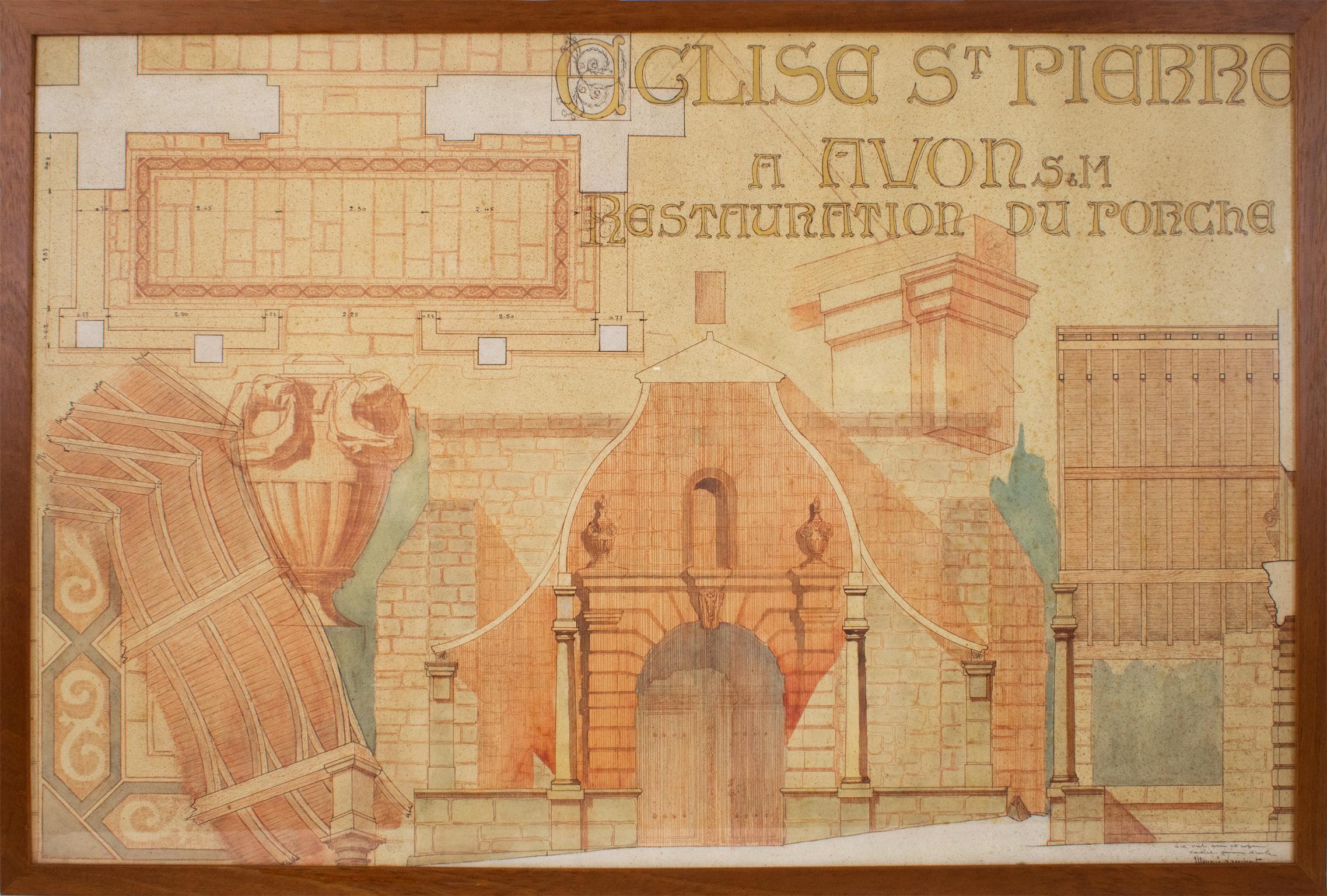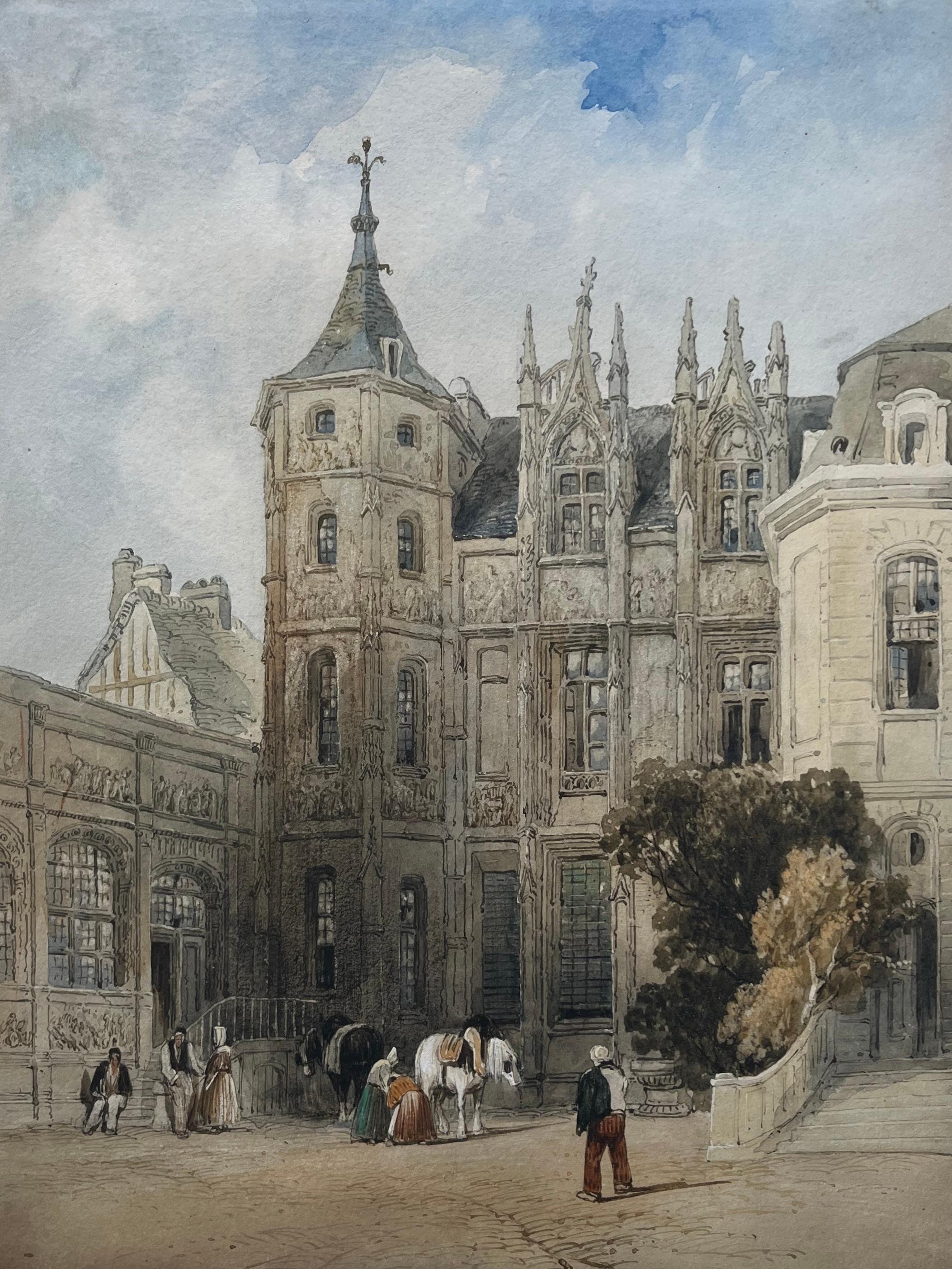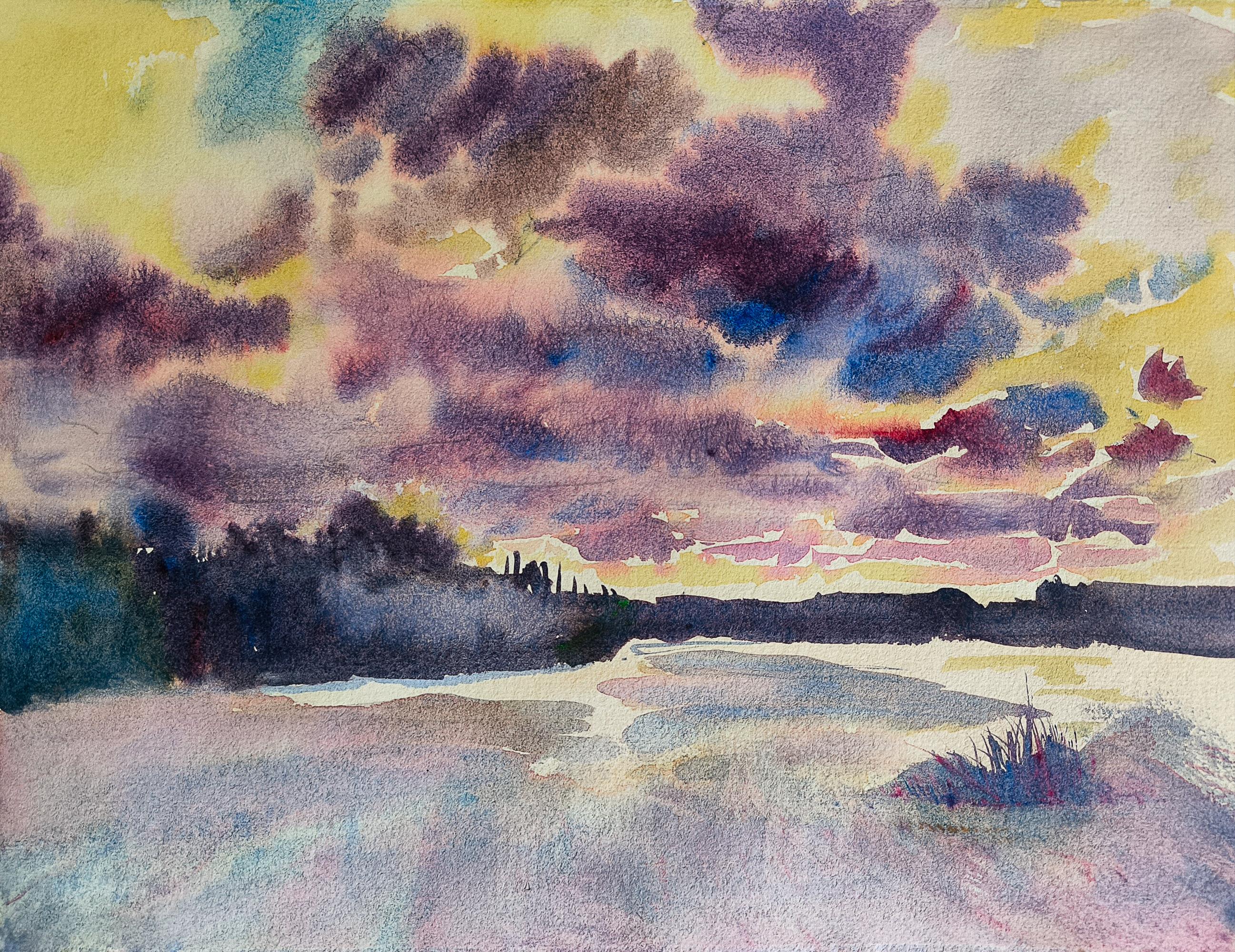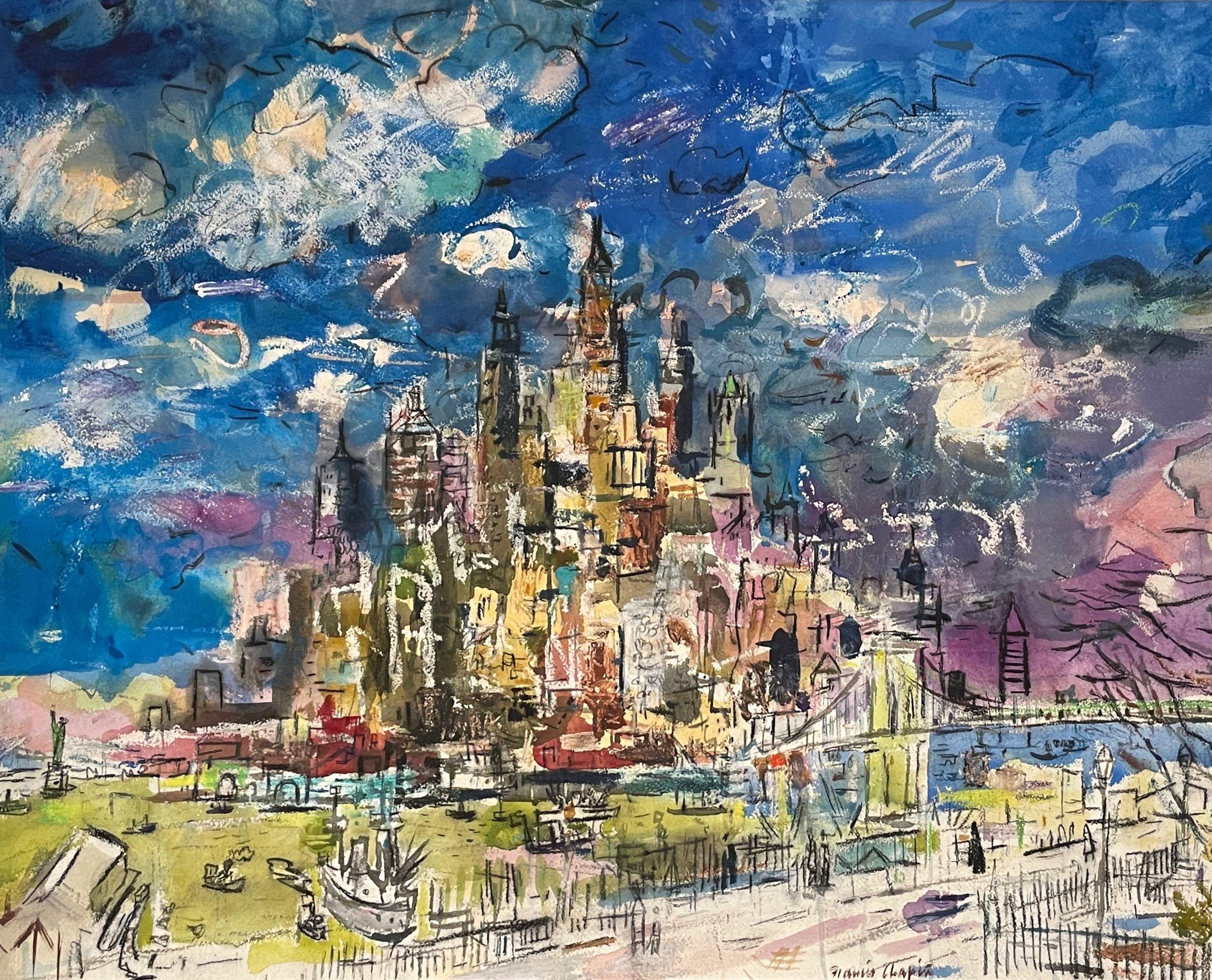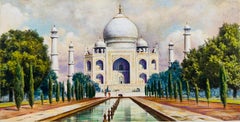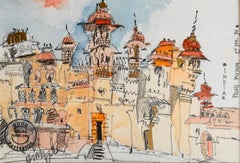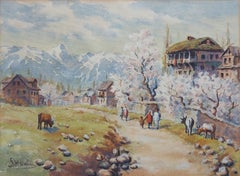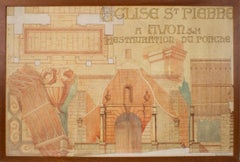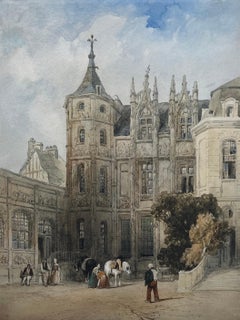Articoli simili a Calcutta India 1841 Acquerello ricco di storia Prima Guerra dell'Oppio Impero Raro
Vuoi altre immagini o video?
Richiedi altre immagini o video al venditore
1 di 17
Francis Meynell Calcutta India 1841 Acquerello ricco di storia Prima Guerra dell'Oppio Impero Raro1841
1841
Informazioni sull’articolo
A historically rich watercolour painting, Calcutta 1841
Francis Meynell (1821-1870)
Calcutta from Garden Reach; HMShip Calliope Saluting
Watercolour on paper
Date: 1841
Signed bottom left; F Meynell, Titled on verso in pencil
Mounted Size: 18.2” x 27” (46cm x 68.5cm)
Image Size:12.1” x 21.45” (31 x 53.6cm)
Provenance: Private UK collection.
‘And the more I explored the background, the clearer it became that the flow of seaborne traffic in the period I was writing about, the first half of the 19th century, was not primarily between India and the West as I had imagined, but between India and China, -or, rather, between one particular place in China, a City called Canton.’
Amitav Ghose - Smoke and Ashes; A Journey through Hidden Histories (Chapter 1 - There be Dragons, Fourth Estate, India, 2023)
Calcutta from Garden Reach; HM Ship Calliope saluting, 1841
At first glance this early 1841 watercolour painting would appear to follow the conventions of the day and present an everyday scene of the rapidly expanding port of Calcutta, to be shared back home in London with audiences eager for images and news of developments in India. This was a time when photography was still very much in its infancy and audiences in the West could only begin to imagine the sights of India through paintings such as this fine watercolour.
However this historically involved painting shows a definitive event in a specific history. As we know there are always multiple sides to every story and this narrative allows us to consider the other contemporaneous histories at this point in India. As Amitav Ghose’s quote lays out, in the 1840’s the majority of seaborne traffic was between India and China. Most importantly it was not just the British travelling East but Indian traders as well. Amongst these groups were the Parsi business families, selling Indian opium to China and setting up the financial family barons of Bombay as it is today. This painting offers an interesting starting point for exploring other histories of the time.The focus of this painting by Francis Meynell dates very specifically to August - September 1841. It shows HM Ship Calliope returning from Canton and the 1st Opium War, triumphantly carrying the bulk of the $6 million dollar ransom in silver bullion, paid by the Chinese to the British. (Clowes, W.L. The Royal Navy: A History from the Earliest Times to the Present. In 7 vols. Vol. 6. London, 1901. P. 294). The image shows a waterway full of trade and activity denoting power and politics.
Through the eyes of the young Lieutenant, at the time aged 20 when he made this artwork, he points us to the administrative centre of Calcutta in all its glory. Painted from Garden Reach on the River Hooghly and the entrance to Calcutta Port our gaze is directed towards Government House, it tells one story of empire and what was seen by the British as advancement, discovery and colony in every possible manner. In style it retains a certain elegance and grandeur, possibly from the young artist’s training back home in London, as he tries to combine all these factors into the one image.
Meynell makes no mistake as he steers our view to the centre of the exciting progressive administrative capital with its grand buildings, governments houses, Cathedrals and docks. Business is thriving and the scene is exciting for the 20 year old Lieutenant who painted this picture and was very much a part of the scene. Having survived the devastating war in China he returns triumphantly on the British war ship which is pulled into the harbour by one of the new steam-powered tugs. Everything in this painting screams success, power and progress in the eyes of the young artist. Titled on the back in pencil, Calcutta from Garden Reach; HM Ship Calliope Saluting, the title confirms this is a painting celebrating military power and trade. The blue Ensign flies proudly, a symbol of the British Navy in India at this period.
To the left of the picture we see the building of the New Botanical Gardens, pointing to the new scientific discoveries being made of the flora and fauna of the Subcontinent. Hastings Bridge to the right demonstrates advancements in engineering. On the water are different forms of transport, the boats carrying both people and freight. Most significantly, from the eyes of the artist it possibly celebrates everything the young military men believed they had been fighting for. Having just returned from one of the bloodiest wars in Canton, the first Opium War, the painting shows a sense of order, of calm and of a city that knows its worth. Ultimately, there is the main focus, the triumphant entry of The Calliope, his ship, bringing ‘home’ the goods: the silver bullion needed to pay the army and feed the troops. A stark contrast to the terrifying scenes he had just come from.
At the time this picture was painted there were a number of European artists working in Calcutta but they were mostly employed in portrait painting or in producing the large picturesque landscape views that were proving popular and financially viable. Looking through most important Museum collections of watercolour paintings of Calcutta in this early 19th century period, paintings of this type are few and far between.
Francis Meynell, who discreetly signed the painting, bottom left, is well documented in the history books (Allen, J. The New Navy List and General Record of the Service of Officers of the Royal Navy and Royal Marines. London, 1853. P. 146). The Royal Maritime Museum in London further holds documents that record his career together with a sketchbook of paintings made on a future voyage to the Americas and letters back to his family. To date very few of his India paintings have come to light but this painting is of a scale, (the wide, quite substantial format also utilised by landscape artists such as Sita Ram and William Prinsep) to suggest he was a confident young painter. The very fine detail of the skyline appears to be an accurate rendition of the significant buildings and the depth of detail is almost akin to that of a miniature painter. Having considered at length, I do not think this painting is faded. To our contemporary eyes the palette is sparse but brown and blue are colours favoured by many landscape artists at this period.
Condition:
The watercolour would appear to have been laid to board in recent times. It has been professionally mounted. There are no rips or tears. Sadly with this matting the title is not currently in view but there is an image attached. The painting has been laid to acid free board. It would be possibly for a professional conservator to lift the watercolour but this is not necessary in terms of preservation.
- Creatore:Francis Meynell (1821 - 1870, Britannico)
- Anno di creazione:1841
- Dimensioni:Altezza: 46,23 cm (18,2 in)Larghezza: 68,58 cm (27 in)Profondità: 2,54 cm (1 in)
- Tecnica:
- Periodo:
- Condizioni:
- Località della galleria:Norfolk, GB
- Numero di riferimento:1stDibs: LU1670216485042
Informazioni sul venditore
5,0
Venditore professionale selezionato
Ogni venditore supera rigorosi standard di autenticità e affidabilità
Fondazione nel 1999
Venditore 1stDibs dal 2021
61 vendite su 1stDibs
- SpedizioneRecupero del preventivo…Spedizione da: Norfolk, Regno Unito
- Politica di reso
Alcune parti di questa pagina sono state tradotte automaticamente. 1stDibs non può garantire che le traduzioni siano corrette. L’inglese è la lingua predefinita del sito.
Garanzia di autenticità
Nell’improbabile caso in cui si verifichi un problema con l’autenticità di un articolo, contattaci entro un anno per ottenere un rimborso completo. DettagliGaranzia di rimborso
Se il tuo articolo non corrisponde alla descrizione, è danneggiato durante il trasporto o non arriva, contattaci entro 7 giorni per un rimborso completo. DettagliAnnullamento entro 24 ore
Hai un periodo di tolleranza di 24 ore per annullare il tuo acquisto, senza necessità di fornire spiegazioni.Venditori professionali selezionati
I nostri venditori di livello internazionale devono aderire a rigorosi standard di servizio e qualità, garantendo l’integrità delle inserzioni.Garanzia miglior prezzo
Se scopri che un venditore ha pubblicato altrove lo stesso articolo a un prezzo più basso, applicheremo lo stesso prezzo.Consegna globale affidabile
La nostra rete di vettori leader del settore offre opzioni di spedizione specializzate in tutto il mondo, inclusa la consegna personalizzata.Altro da questo venditore
Mostra tuttoIndia Taj Mahal Acquerello originale per l'iconica cartolina da sigaretta dell'uomo di chiesa del 1910 circa
Acquerello originale per l'iconico Churchman's
Cartolina di sigaretta del Taj Mahal
Acquerello su carta
c 1910
Dimensioni dell'immagine: 7 x 14 cm
Provenienza: Collezione privata d...
Categoria
Inizio XX secolo, Altro stile artistico, Disegni e acquarelli (paesaggio)
Materiali
Carta, Acquarello
India Acquerello RCA Architetto Pittura Palazzo Udaipur Lago Viaggio Arancione Blues
I disegni e gli schizzi realizzati dagli architetti hanno un fascino particolare. Sciolto e pieno di vita, questo delizioso piccolo studio, realizzato sul posto, cattura magnificamen...
Categoria
Anni 1990, Contemporaneo, Disegni e acquarelli (paesaggio)
Materiali
Acquarello, Carta per archivio, Matita
India XIX sec. Paesaggio britannico quotato Artista Alfred Crowdy Lovett Palma Botanica
Alfred Crowdy Lovett C.B.E. (britannico, 1862-1919)
Albero di palma e noce di cocco di palma (a matita sul verso), palma singola firmata in alto a destra
Acquerelli su carta, monta...
Categoria
Fine XIX secolo, Postimpressionismo, Dipinti (paesaggio)
Materiali
Carta, Acquarello
Valle del Kashmir Mandorlo in fiore Dina Nath Walli Paesaggio di montagna India Arte
Dina Nath Walli (1908-2006)
Mandorlo in fiore, Kashmir
Acquerello su tavola
c 1960
Dimensioni della cornice: 42,8 cm x 52,8 cm
Dimensioni dell'immagine: 27,5 cm x 38 cm
Firmato e dat...
Categoria
Metà XX secolo, Impressionismo astratto, Dipinti (paesaggio)
Materiali
Tavola, Acquarello
Madras Collection'S di disegni acquerellati su carta e cartoncino India inizio 20° C.
Collezione di tre grandi acquerelli, due dei quali incorniciati. Con altri 15 disegni a inchiostro della favolosa artista irlandese Ismaena R Warren, prolifica illustratrice di libri...
Categoria
Inizio XX secolo, Altro stile artistico, Disegni e acquarelli (paesaggio)
Materiali
Carta, Acquarello, Inchiostro di china, Acrilico
India 3 X Schizzi di campo della frontiera NW del Kashmir del XIX secolo Lago Manasbal, Kashmir
3 Schizzi sul campo, sul posto
Frontiera nord-occidentale dell'India : Lago Manasbal, Kashmir
Artista: Sconosciuto
Mezzo di comunicazione: Penna e inchiostro
Creato: 1890s
Dimension...
Categoria
Anni 1910, Altro stile artistico, Disegni e acquarelli (paesaggio)
Materiali
Carta, Inchiostro, Penna
Ti potrebbe interessare anche
Schizzi di architettura Disegno di studio, Chiesa di Roman Frances in Francia di Maurice Lambert
Studio architettonico per il restauro della chiesa di Saint-Pierre ad Avon, Francia.
Questo studio architettonico unico nel suo genere è stato realizzato nell'ambito di un progetto d...
Categoria
Fine XIX secolo, Accademia, Disegni e acquarelli (paesaggio)
Materiali
Inchiostro, Acquarello, Matita, Carta per archivio
Cotman, Norwich School, Acquerello inglese di Rouen, Francia
Di John Sell Cotman
Una bella composizione che cattura uno dei famosi edifici di Rouen, una città molto popolare tra i pittori di acquerelli dell'inizio del XIX secolo. John Sell Cotman dipinse proprio ...
Categoria
Inizio XIX secolo, Vittoriano, Disegni e acquarelli (paesaggio)
Materiali
Carta, Acquarello
"Montagne delle Ande, Perù, Sud America", Joseph Yoakum, Paesaggio folkloristico nero
Di Joseph Yoakum
Joseph Yoakum
Montagne delle Ande, Perù, America, 1960 circa
Matita colorata e penna a sfera su carta
7 1/4 x 10 1/2 pollici
Provenienza:
Galleria Karen Lennox, Chicago
Collezione p...
Categoria
Anni 1960, Arte popolare, Dipinti (paesaggio)
Materiali
Carta, Acquarello, Penna a sfera, Matita colorata
17.600 USD Prezzo promozionale
20% in meno
"Gondole al molo, Venezia, Italia" Louis Wolchonok, Scena di barche nel porto
Di Louis Wolchonok
Louis Wolchonok (1898 - 1973)
Gondole in banchina, Venezia, Italia, 1928
Acquerello su carta
Vista 18 x 23 1/2 pollici
Firmato e datato in basso a destra
Louis Wolchonok era un auto...
Categoria
Anni 1920, Postimpressionismo, Disegni e acquarelli (paesaggio)
Materiali
Carta, Acquarello
2.000 USD Prezzo promozionale
20% in meno
"Vasta distesa d'acqua" - Paesaggio sereno ad acquerello
Immergiti nel mondo sereno e contemplativo di "Vast Expanse of Water", un'accattivante pittura ad acquerello dell'affermata artista Linda Clerget. Quest'opera mette in mostra la padr...
Categoria
XXI secolo e contemporaneo, Impressionismo, Disegni e acquarelli (paesag...
Materiali
Acquarello, Carta fatta a mano
Una dinamica scena di Manhattan in stile Mid-Century Modern, New York City di Francis Chapin
Di Francis Chapin
Un grande e dinamico acquerello di metà secolo moderno di Lower Manhattan, New York, realizzato dal noto artista di Chicago Francis Chapin (Am. 1899-1965). L'immagine è realizzata a...
Categoria
Metà XX secolo, American Modern, Dipinti (paesaggio)
Materiali
Acquarello, Carta per archivio, Carboncino, Pastelli
